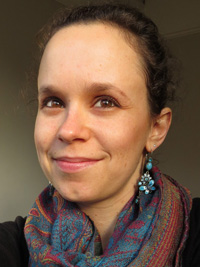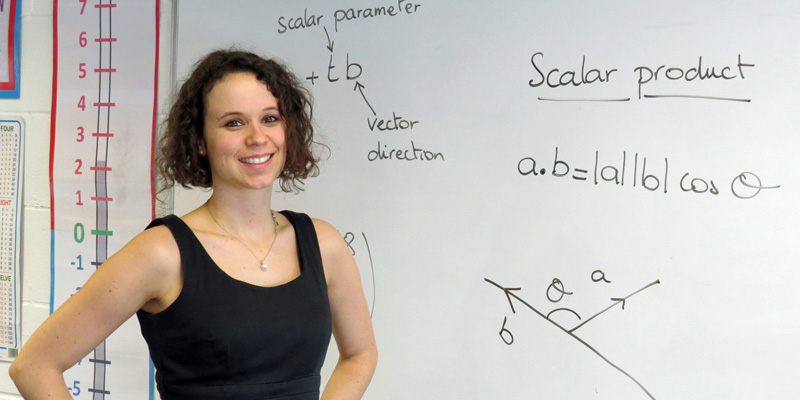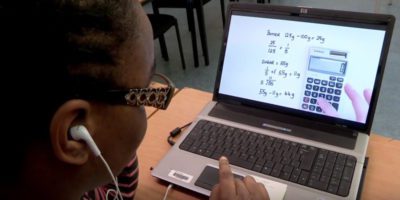Valerie Vincent is a maths teacher at The Compton School in North Finchley, London. She holds a Master’s degree in Process Engineering and Environment from the INSA Toulouse in France and studied renewable energies with the ERASMUS exchange program at Linköping University (LiU) in Sweden. After a successful career as an engineer at Airbus, Valerie decided to become a maths teacher and now enjoys linking concepts with real life through discussions and experiments in her lessons, as well as running a Maths in Motion club.

“…In schools, as well as at home, girls and boys should be treated equally when it comes to expectations, support and opportunities…”
Being part of a multi-national company was good, but having a direct impact on children’s lives and their ability to achieve is amazing
After obtaining my Master’s degree in engineering, I worked for a year in a London-based company, designing rainwater and greywater systems. I then moved back to France to work for Airbus in Toulouse where I was helping with the project management of the fire detection and fire protection systems for the new A320 Neo aircraft.
Being part of such a successful company was exciting and I was glad to play a part in the design of a new technology system. At the same time, I was volunteering once a week for a charity helping disadvantaged teenagers with homework. I had always kept the idea of becoming a teacher in my mind and this voluntary work made me realise that teaching young people was what I really wanted to do. Being part of a multi-national company was good, but having a direct impact on children’s lives and their ability to achieve was amazing.
I decided to go back to the UK and, after a few months, I heard about the Get into Teaching campaign, which presented the perfect opportunity for me. I visited several schools and spent a week at The Compton School in North Finchley, Barnet. I loved it and decided to apply for The Compton SCITT (School Centred Initial Teacher Training) to train as a maths teacher. The year was intense but the quality of the training as well as the support I received were both excellent.
I have been working as a fully qualified teacher for two years now, and I have even started teaching A-level maths this year. I am so pleased with my choice to become a maths teacher!
Sharing innovative approaches to teaching
On a day-to-day basis, my time is mostly divided between teaching, planning and creating resources, and marking. I also spend time running clubs, communicating with parents or other members of the school about children’s progress and taking part in meetings and CPD (continuing professional development) training sessions.
At The Compton, innovative approaches are shared, discussed and used in the classroom. The Teaching and Learning team is very pro-active in learning about new relevant publications or research which is then shared with the rest of the school through CPD sessions or in the Teaching and Learning newsletter, published every half term.
Equally, the Compton SCITT (School Centred Initial Teacher Training) works in parallel with the Teaching and Learning team to make sure that innovative approaches are taught to future teachers. As a result, both the school and the SCITT have been rated as “outstanding” by Ofsted.
Reversing gender inequality and reassuring girls that “they can do it”
Currently the uptake of girls choosing to study A-level maths and physics is low and we all need to work on addressing this. Our society is making progress in the right direction in terms of gender equality, but there are still inequalities in the workplace.
Even today, the majority of executive positions, and especially the ones related to new technologies, are held by men. Because so few women are present in these industries, girls are not necessarily attracted to these kinds of jobs as they struggle to identify with the current workforce. This is a vicious circle – fewer girls will be choosing to study scientific topics and fewer women will be working in the scientific world. But I would like to see this reverse in future, replacing the “fewer” with “more”.
To achieve this, we have to act both in schools and in the professional world. In schools, as well as at home, girls and boys should be treated equally when it comes to expectations, support and opportunities. Instilling confidence in girls is crucial for them to develop an “I can do it’’ mindset, which is key to learning in maths or physics.
Using discussions to link concepts to real life in my lessons
For me, as a teacher, linking maths concepts to real life is key to students’ enjoyment of the subject and enables them to understand why mathematical knowledge is so important in everyday life.

During my lessons, students apply concepts that they have just learnt to real life problems. As an example, my GCSE students use 3D Pythagoras to work out the length of the vertices of the Great Pyramid of Giza, and my Key Stage 3 students use coordinates to work out the location of a Mayan lost city.
I also try to apply these concepts to teaching A-level. For example, I recently used the trajectory of a cartoon character to explain the use of parametric equations. I also think that asking students to link their own interests to maths is a great way to make them curious and want to learn even more. Last year, my Year 9 students made some amazing presentations about maths and music, maths and cipher, maths and bees and maths and beauty.
Colourful and interesting corridor displays are another perfect way to ignite students’ curiosity about maths. The following are all displays that the maths department created for the corridor this year:
- “How does Google know where I am?’’
- “How old is this mummy?’’
- “How can I score the perfect penalty?’’
- “How can I predict the future?’’
New resources and technology are helping to bring maths to life for our pupils
New resources and technology, such as interactive whiteboards, are an excellent way to bring maths to life in the classroom. Being able to show videos and use specific maths tools directly on the board are great ways to make maths more interactive. At the Compton, we also have a lesson in an ICT classroom every two weeks with each of our classes.
The students really enjoy these lessons and they get to use maths specific software such as MyMaths, Mangahigh and MathsWatch, designed to suit different needs and abilities.
Helping students understand how they can apply maths in their careers
I feel that it is very important to help students understand how they could use maths in their career. They often think that what they learn in class will not be transferrable to everyday life. Students need to see how maths is necessary and used every day in many careers such as hospitality, retail, banking, medicine, engineering, design and architecture. Linking maths concepts to real-life situations inspires students and helps them realise the importance of these concepts to their future careers.
Heading to Ghana

Next year, I am looking forward to carrying on teaching Key Stages 3, 4 and A-level at The Compton, ready to encourage more girls to follow and enjoy a scientific path.
In 2018, The Compton will be opening a new free school. This is an excellent opportunity to allow collaborative teaching between the two schools, making sure that more and more students are being taught with the outstanding methods already in place at The Compton.
Interested in inspiring children to get into maths? To find out more and explore your options as a teacher, contact the Get Into Teaching line on 0800 389 2500 or visit getintoteaching.education.gov.uk.
There is a particular demand for teachers in a range of subjects, including; maths, physics, chemistry, computing, geography, biology and languages. Free workshops are being held offering one-to-one support with your application to teacher training: getintoteaching.education.gov.uk/teaching-events/application-workshop-events.
https://getintoteaching.education.gov.uk
https://twitter.com/getintoteaching
https://www.facebook.com/getintoteaching
https://www.youtube.com/user/getintoteaching
The Great Pyramid of Giza image credit: Nina at the Norwegian bokmål language Wikipedia [GFDL (http://www.gnu.org/copyleft/fdl.html), CC-BY-SA-3.0 (http://creativecommons.org/licenses/by-sa/3.0/) or CC BY 2.5 (http://creativecommons.org/licenses/by/2.5)], via Wikimedia Commons





